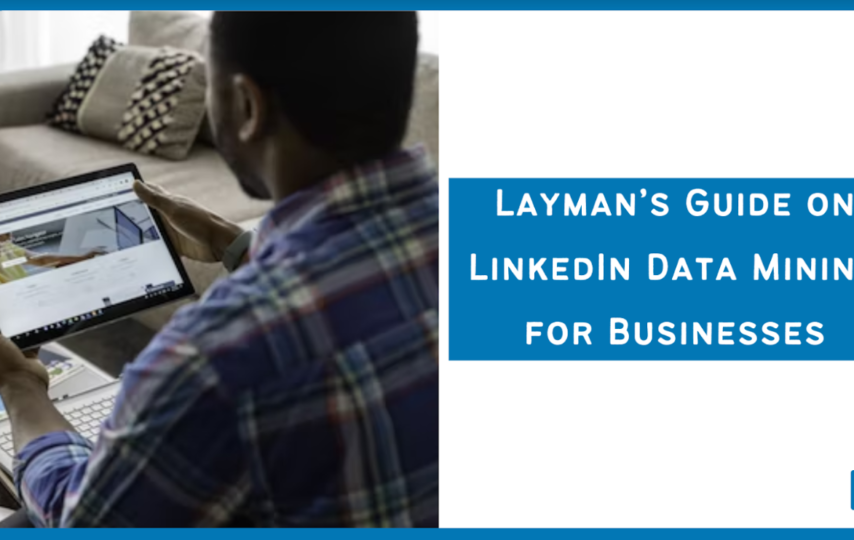Scraping data from LinkedIn can be a valuable tool for businesses looking to gather information about their industry, competitors, and potential customers. In this guide, we’ll cover the basics of how to scrape LinkedIn data and some best practices to keep in mind as you do so.
Before we begin, it’s important to note that LinkedIn’s terms of service do not allow anyone to scrape private data from the site; only publicly available data can be scraped. It’s also worth considering whether the data you are seeking can be obtained through other sources since mining LinkedIn can be challenging and needs someone polished at this to achieve desired results. Otherwise, you can hire LinkedIn scraping services from an experienced LinkedIn data mining services company to get this done cost-effectively and efficiently.
With that said, let’s dive into how to scrape LinkedIn data.
Tools and Prerequisites
To scrape LinkedIn data, you can use a few professional tools. First and foremost, you’ll need a web scraper. You will find many options. Some popular choices include import.io, ParseHub, and Web Scraper.
In addition to a web scraper, you’ll also need a LinkedIn account and the ability to send connection requests. If you don’t have a LinkedIn account, you can sign up for one for free. Keep in mind that LinkedIn may limit the number of connection requests you can send if you have a new or low-activity account.
Finding the Data You Want
The first step in scraping LinkedIn data is identifying the information you want to gather. LinkedIn has a vast amount of data available, including profiles, company pages, job listings, and more. As you determine what data you want to collect, consider the following:
- Is the data publicly available, or will you need to be connected to the individuals or companies in order to access it?
- Is the data you want to collect available through LinkedIn’s APIs or other means? If so, it may be more efficient to use those methods rather than scraping the data.
- How will you use the data once you have it? Be sure to consider any legal or ethical implications of your intended use.
Once you have a clear idea of the data you want to collect, you can start thinking about how to structure your web scraper to extract it.
Setting Up Your Web Scraper
The specifics of setting up a web scraper will depend on the tool you are using. In general, you’ll need to specify the URL of the LinkedIn page you want to scrape and the elements on the page that contain the data you are interested in.
For example, if you want to scrape the names and job titles of individuals on LinkedIn, you might set up your web scraper to extract the text from the h1 and h2 tags on each profile page.
It’s a good idea to test your web scraper on a small number of pages before running it on a larger scale. This will allow you to make sure it is correctly extracting the data you want and troubleshooting any issues that may arise. However, it gets hard to put your mind to all the technical aspects of data mining. To save time and money, it’s always better to outsource LinkedIn scraping services to an expert team.
Best Practices for Scraping LinkedIn Data
As you scrape LinkedIn data, there are a few best practices to keep in mind:
- Determine your goal for scraping LinkedIn data. Do you want to gather information about potential leads, track the growth of your company’s page, or do something else? Having a clear goal will help guide your data collection efforts.
- Research and select a web scraping tool. There are many options available, both free and paid. Some popular tools used by the top data mining company list include Import.io, ParseHub, and Octoparse. Consider factors such as the size of the data you need to collect, the complexity of the LinkedIn pages you need to scrape, and your budget.
- Familiarize yourself with the tool you have chosen. Most web scraping tools will require you to build a “project” or “crawler” to specify which data you want to collect and how you want it to be structured. Some tools have a visual interface for building projects, while others require you to write code.
- Test your project on a small scale to ensure it is working as intended. It is a good idea to start by collecting a small amount of data and checking that it is accurate and complete.
- Set up a schedule for data collection. Depending on your goal, you may want to scrape LinkedIn data on a daily, weekly, or monthly basis. Most web scraping tools allow you to schedule projects to run automatically at a specified interval.
- Analyze and utilize the data you have collected. Once you have a sufficient amount of data, you can begin to draw insights and make data-driven decisions for your business. Some common ways to use LinkedIn data include identifying potential leads, tracking the growth of your company’s page, and analyzing the success of your marketing efforts.
- Follow best practices when scraping LinkedIn data. Be respectful of LinkedIn’s terms of service and the privacy of its users. Do not scrape sensitive or personal information, and be transparent about your data collection efforts.
By following these steps, you can effectively scrape data from LinkedIn to benefit your business.
How Are Experts Using LinkedIn Data Scraping for Talent Discovery?
Many companies, recruiters, and LinkedIn data mining services use LinkedIn to find and evaluate potential candidates for job openings. If you are looking to use LinkedIn as a tool for talent discovery, there are a few ways you can go about it.
1. LinkedIn’s built-in search and filtering tools – You can search for specific keywords, job titles, companies, skills, and more, and use LinkedIn’s advanced filters to narrow down your results. This can be a quick and easy way to find potential candidates, but it may not be as effective as some other methods.
2. LinkedIn’s API (Application Programming Interface) – This allows you to extract data from LinkedIn and use it for your own purposes, such as talent discovery. However, it’s important to note that LinkedIn’s API terms of service prohibit the use of automated scraping tools, so you will need to be careful if you decide to use this method.
3. Third-party tool or service – These tools and services can help you extract data from LinkedIn in a more automated and efficient manner, but they may not always be reliable or accurate. It’s important to research and choose a reputable provider if you decide to go this route.
Ultimately, the best way to use LinkedIn for talent discovery will depend on your specific needs and goals. It may be worth experimenting with different approaches and seeing what works best for you. Or, you can always reach out to experts for LinkedIn scraping services and find accurate data as per your need.
Using LinkedIn Data Scraping To Drive Better Investment Decisions
For investors, LinkedIn can be a valuable resource for gathering information on potential investments. By scraping public data from LinkedIn profiles, investors can gain insights into the professional backgrounds and experiences of company executives and decision-makers, which can help inform investment decisions.
One way to scrape LinkedIn data is to use a web scraping tool, such as Octoparse or ParseHub, which can extract data from LinkedIn profiles and compile it into a spreadsheet or other format. These tools work by sending a request to LinkedIn’s servers to retrieve the HTML code of a profile page, and then they parse the code to extract the desired data.
Some of the data that can be useful for investors includes:
- Professional experience: This can give investors an idea of the executive team’s background and experience in the industry.
- Education: This can provide insight into the team’s level of education and expertise.
- Skills: LinkedIn profiles often list the skills and expertise of professionals. This can be useful for investors to understand what the team is capable of and whether they have the necessary skills to drive the company’s growth.
- Connections: LinkedIn profiles often show the connections that a person has within their industry. This can be useful for investors to understand the team’s network and the potential for partnerships and collaborations.
How Does Outsourcing LinkedIn Data Mining Services Help Businesses?
Outsourcing LinkedIn data mining services can be a valuable option for businesses looking to collect data from the platform without taking on the task themselves. By partnering with a professional data mining company, businesses can access a team of experts who are well-versed in using LinkedIn’s API and web scraping tools to collect and analyze data.
- Data mining can be a time-consuming and technical process, and outsourcing it to a service allows businesses to focus on their core competencies while still being able to access valuable data.
- A professional service will have a deep understanding of how to use LinkedIn’s API and web scraping tools to collect the most relevant and accurate data for a business’s needs. They can also provide valuable insights and analysis of the collected data to help a business make informed decisions.
Overall, outsourcing LinkedIn data mining services can be a cost-effective and efficient way for businesses to access valuable data from the platform and use it to improve their marketing efforts and reach their business goals.
Bottom Line
In conclusion, LinkedIn is a powerful platform for businesses looking to connect with other professionals and generate leads. Following the steps outlined in this guide, you can effectively use LinkedIn for your business and maximize its potential.
Overall, LinkedIn is a valuable resource for businesses looking to grow and connect with other professionals. Using its features and tools, you can effectively use LinkedIn to achieve your business goals.








